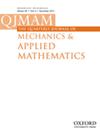柔性通道流中撞击的低阶模型
IF 0.8
4区 工程技术
Q3 MATHEMATICS, APPLIED
Quarterly Journal of Mechanics and Applied Mathematics
Pub Date : 2015-08-01
DOI:10.1093/QJMAM/HBV009
引用次数: 6
摘要
在模拟中,有限长度柔性通道中高雷诺数流的大振幅自激振荡经常表现出剧烈的重复“猛烈撞击”运动,在此期间,通道在其下游端附近短暂地几乎完全被阻塞,然后迅速重新打开。在这里,我们使用二维物理系统的一维PDE模型来分析这种近奇异行为。在一个显著的渐近极限下,我们系统地导出了接近轰击状态时的低阶微分/代数模型。收缩处附近通道的形状由膜张力和流体惯性之间的平衡决定;该区域也是粘性耗散的主要位置,它平衡了沿通道分布的能量变化。简化的模型准确地捕获了一组稳定的溶液分支及其稳定性,并显示了猛烈撞击是如何与膜下游刚性通道的特性强耦合的。在低阶模型中发现了一个奇点,它可以解释撞击事件结束时气流的剧烈调整。本文章由计算机程序翻译,如有差异,请以英文原文为准。
A low-order model for slamming in a flexible-channel flow
In simulations, large-amplitude self-excited oscillations of high-Reynolds-number flow in a finite-length flexible channel often exhibit vigorous repetitive ’slamming’ motion, during which the channel briefly becomes almost completely occluded over a very short lengthscale near its downstream end before rapidly reopening. Here we analyse this near-singular behaviour using an established one-dimensional PDE model of the two-dimensional physical system. Working in a distinguished asympotic limit, we systematically derive a low-order differential/algebraic model for the flow when it is close to the slamming state. The shape of the channel near the constriction is determined by a balance between membrane tension and fluid inertia; this region is also the predominant site of viscous dissipation, which balances energy changes distributed along the channel. The reduced model accurately captures a set of steady solution branches and their stability and shows how slamming is strongly coupled to the properties of the rigid channel downstream of the membrane. A singularity is identified in the low-order model which may explain the violent readjustment of the flow at the end of a slamming event.
求助全文
通过发布文献求助,成功后即可免费获取论文全文。
去求助
来源期刊
CiteScore
1.90
自引率
11.10%
发文量
14
审稿时长
>12 weeks
期刊介绍:
The Quarterly Journal of Mechanics and Applied Mathematics publishes original research articles on the application of mathematics to the field of mechanics interpreted in its widest sense. In addition to traditional areas, such as fluid and solid mechanics, the editors welcome submissions relating to any modern and emerging areas of applied mathematics.

 求助内容:
求助内容: 应助结果提醒方式:
应助结果提醒方式:


